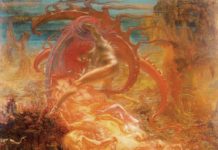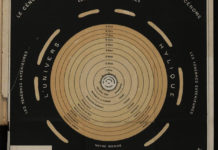Hi friends, thanks for reading this blog.
If it wasn’t for the fans and the circle of friends forming around these posts then it wouldn’t be quite the same. You, the reader, keep this blog alive. So thank you. 🙂
As most of you know by now, I am reviewing the various Rosicrucian Orders.
The idea is not to attack any particular Orders, but to look, objectively, at how well the various Orders represent the age old tradition. It is not done in any way to discredit any Order, but rather is part of a process in aligning our pursuits to the pure Rosicrucian stream.
Let me start out here by saying however; I don’t believe in the idea of ‘a perfect Order.’
If an Order scored perfectly using the system then it is static and belongs to the past. Indeed many Orders have progressed and moved forwards. But some so much so that they have lost touch with their beautiful roots, and my wish is to help students to ‘reimagine’ our mystery.
The Rosicrucian manifestos are tales caste within a dream-like world, of adventure where our hero Rosenkreuz discovers not only Hermes but also Venus. With the god Apollo on his side he travels on a quest, making new friends, uniting them together in fraternal bonds. The message is quite clear; they stand for a Love of Wisdom, and believe in the regeneration of all humanity.
This quest and union of friends is an ideal we can all learn from, and hopefully some of you will join me as we unlock the Rosicrucian mystery together, even unto the door of Venus.
Martinist Review Installment
Today’s post will continue the Review of the Martinist Order, covering how the M.O performs against the second of three Rosicrucian Pillars from my scoring system.
To recap, there are three main Rosicrucian Pillars of the old tradition:
- Trinosophia. (Magic, Alchemy, Cabala)
- Hermetic Christianity.
- Pansophy.
My last post reviewed the M.O for its Trinosophia traditions (called in the final Rosicrucian manifesto, the Pegasus of the Firmament, as the Triplici Philosophorum), scoring them with a Trinosophia score of 16/30. This score wasn’t easy because some M.O’s have extremely strong alchemical traditions, which are from the heavy weights of alchemy. But because of the wide range of variation between all the Orders a general mean had to be arrived to.
Today’s post is different. The doctrines on these subjects are quite clear.
This blog post continues by scoring the M.O with a Christianity score. If you are new here and don’t know why I’m doing this: well, it’s because I love our tradition.
The source documents of the R.C were written brilliantly, and I believe few Rosicrucian Orders embody the full spectrum of what the entire tradition has to offer.
That is why my Rosicrucian Pillars first defined ‘where we came from,’ and now these reviews shed light on ‘where we are now.’ Only then can we steer the ship.
The final entries will be a drafted proposal on how to reform the Rosicrucian Orders (starting with my own Mystica Aeterna) to truly represent the brilliance of our lovely tradition.
Other Orders may want to follow, by uniting in a Pansophic Union. That is up to them. Some will find these endeavors snooty. That is all good too. 😀
Indeed you can’t make everyone happy. But this blog is a mission.
Martinist Review Section Two: Christosophia Score
Martinist Christianity vs. Rosicrucian Christianity
The second pillar after my previous review is that of Christosophia, and by that I do not mean Catholicism, or Protestantism, but to be precise the Christianity outlined in the manifestos.
(Note that I’ve started using the term ‘Christosophia’ to indicate the emphasis upon the female Wisdom of Theosophy and the Venus of the Rosicrucians.)
Having a strong Christ symbol and presence is worth ten points for the score, plus another ten points if that Christianity is not just ‘Christian alone’ but also resembles Hermetic influence.
Now, how strongly does the Christosophia of the M.O match that of the R.C?
Christosophia 1: Christ Symbol Score
Any Rosicrucian Order should depict a Christ symbol.
I might add here that recent comments have been made in our Facebook community that ‘Christianity is not a part of the Rosicrucian tradition,’ but only shows a ‘dogma’ from which ‘the modern R.C has departed.’
Now, before I go all ‘gangsta on that ass’ let me state here that I am NOT Christian, but I do accept the idea of the Repairer, and I know better than to try and remove Christ.
You see there is a problem with the above line of thinking. If you were to do a quick survey of just how many Rosicrucian Orders there really are – you’d then be able to survey just how many are Christian or teach Christian mysticism. Just look at the major Orders here:
- Martinism
- AMORC/CR+C
- Rose Croix degree of Freemasonry
- Society of Rosicrucians in Anglia
- Society of Rosicrucians in America
- Rosicrucian Fellowship
- Lectorium Rosicrucianum
- RR et AC (Golden Dawn’s Rosicrucian Inner Order)
- Builders of the Adytum
These constitute the largest groups out there. Guess what… only ONE of them isn’t Christian.
Even the RR et AC of the G.D is a Christian Inner Order according to its founders. Paul Foster Case of the B.O.T.A was a Christian. Thus there is one group here making sweeping statements about the greater Rosicrucian tradition for us all, despite the fact that the majority represents the greater tradition, and that majority of Orders ARE Christian.
Not being Christian myself, I see Christ as a personal image of regeneration, a reflection of all the Hermetic powers projected into one being, as Bruno described with his Primordial Repairer.
Being a traditionalist, I wouldn’t even consider the idea of throwing out Christ.
But my views here have also described symbols in the manifestos that most people ignore, such as Venus and Apollo, and as we shall see the relationship between Rosenkreuz and Asclepius, god of healing, which help those with a Hermetic bent like me. 🙂
Thus there can be no ‘Rosicrucian without Christ.’
Or as the Fama says: ‘Jesus Mihi Omnia’ meaning – Jesus is my All.
Now, moving on:
In the realm of Martinism we find a very Christian mystical Order.
Clearly Louis Claude de Saint Martin praised Christ. So did his master Boehme.
In the Order itself the symbol of the cross features not only in the Martinist pentacle but the figure of Christ is emphasized through the mystical letters of Yehashua. LCM refers to Christ as ‘the Repairer,’ a title given as the main trigger to Reintegration.
Pay attention, because there is indeed a difference between the Martinist Christ and that of religious Christianity. In the realm of the M.O we find an esoteric Christ, just as the Adam of Eden has been projected into a supersensible Primordial Deity, which was split apart by a mystical fall from grace.
The Repairer of Saint Martin goes beyond the religion of Christ and becomes mystical.
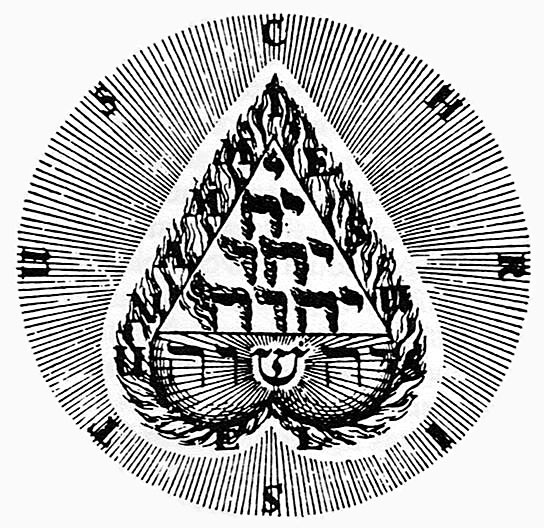 Saint Martin echoed the words of his master Boehme, saying that Christ had to be enshrined within the heart. Boehme resembled this concept with his tetractys symbol of flaming Hebrew letters. Martinism, if you have so far agreed with me, not only belongs to LCM but also to Boehme. Thus Martinism, via Boehme, does indeed have a wonderful symbol for Christ and receives a high score here in terms of the review system.
Saint Martin echoed the words of his master Boehme, saying that Christ had to be enshrined within the heart. Boehme resembled this concept with his tetractys symbol of flaming Hebrew letters. Martinism, if you have so far agreed with me, not only belongs to LCM but also to Boehme. Thus Martinism, via Boehme, does indeed have a wonderful symbol for Christ and receives a high score here in terms of the review system.
The symbol depicted shows how the heart receives the light of God, and that Christ is born within the temple of the heart. Thus the mystical Christ of Martinism is not only something of faith, but also something to experience directly, in a form of Gnosis.
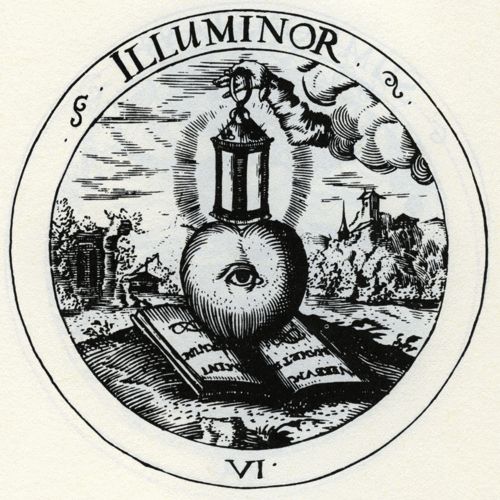 Boehme added other features to the heart or cross throughout his other images, such as the ‘eye’ and ‘anchor.’ The eye upon the heart shows the beginning of awakening and the anchor steadfast resolute faith.
Boehme added other features to the heart or cross throughout his other images, such as the ‘eye’ and ‘anchor.’ The eye upon the heart shows the beginning of awakening and the anchor steadfast resolute faith.
Clearly the ‘Rosicrucian Emblems’ of Cramer are connected to Boehme’s ideas placing his mystical heart symbols well within the realm of the early Rosicrucian tradition. In the Cramer symbols indeed the Theosophy of Boehme entirely meets the Rosicrucians. At this point the two traditions become inseparable.
The Martinist Order receives 8/10 for its Christ Symbol Score.
There are several Christian mystical diagrams from Boehme also worth exploring. The final two points for a clean ten out of ten have been held back because these symbols are not official emblems of the M.O, which mainly uses the Martinist Seal. It is a cross on a hexagon, but you don’t see Christ… I am inclined to think here that the Christ figure which appears in the Seal of the German Golden Rosenkreuzer actually resembles something more truly ‘Rosicrucian.’
At the same time I’d only give the GuR+C seal a 9/10 because it needs uncle Hermes…
Christosophia 2: Hermetic Christianity
The Rosicrucian version of Christianity as shown in the manifestos is highly esoteric.
And remember, there are six Rosicrucian manifestos. You’ve heard me mention them before. This time I’ll share their story, because there are ‘higher works’ at hand.
This segment also goes further into why I attest the R.C were Christian-Hermeticists, and not just Protestants to be exact. Here is what really happened:
The first of the Rosicrucian manifestos is truly a document titled the ‘Reformation of the Whole Wide World by Order of Apollo.’ In it Apollo commands his seven sages of Greece to go forth and regenerate humanity. In the next three manifestos, which are commonly known as the ‘three main’ Rosicrucian manifestos, this sun god and his seven sages enact upon a Christian brotherhood, who become the Rosicrucians. The Rosicrucian currents of the early 1900’s missed these details and focused only on the ‘outer mysteries’ of the Rosicrucians, which appear to be a surface layer of Christianity in the manifestos. But what you see is not what you get.
In fact it was Bruno, the great Hermeticists, who put all of these powers into action. Reading into the Hermetic works, he saw the prophecy that someday the gods of Egypt shall return, and be installed into a talisman structure. It was he who first wrote of Apollo’s wish to descend and rescue a degenerated humanity, which had fallen into a barbarous culture. Bocanelli’s treatise, the Reformation of the World by Apollo, is but an expansion on that piece from Bruno.
Bruno believed that the higher plane was of the gods, and that the reformation first had to take place in that realm, before it could occur on the material plane. He formulated a magical ceremony for that reformation, within a talisman seven sided structure, that was to become the seven sided tomb of Christian Rosenkreuz, a device that was to receive those powers.
Thus there are two layers to the manifestos, a microcosmos and macrocosmos.
And as I suggest above, an outer Rosicrucian mystery and an inner one.
On the spiritual plane the manifestos are enlivened with Egyptian powers.
On the material plane the manifestos have Christians fulfill that dream.
The powers above that Bruno invokes had to be manifested in the time and place of Europe, which was Christian. As above, so below, one is the work of the intentions of the other.
Bruno described how the gods had met in a higher plane, and that at Olympus Isis and Jupiter assembled them all there to discuss the reformation on earth. Clearly these powers required a material vessel in which to enact their vision. Thus that worldly regeneration would be carried out by Christian monks in the real world, who had received the impulse from above.
The three Christian manifestos after the Apollo show all of this working out on our plane.
And we haven’t even touched upon Venus and Asclepius yet… more soon. 😉
Bruno’s works were written prior to 1600. The R.C manifestos from 1611-1618.
Thus we see a clear awareness of the connection to the Hermetic powers, on the part of the manifesto authors. But when the Orders of the mid 1800’s to early 1900’s were formulated they were not as aware as we are today. That is why many of them are strictly Christian.
Mystical Orders like Amorc though are right; the R.C is a lot more universal than just Christianity. At the same time they utterly failed by removing these agents of the gods.
As to the Christianity of Martinism; it certainly is NOT regular Christianity.
The Order is named after Saint Martin but Saint Martin based his work on his two masters Boehme and Pasqually. In fact there is nothing new in Saint Martin’s books, and I do not regard LCM very highly. In many respect he departs from Rosicrucian thought, where his master Boehme appears much closer to the source; Pansophy/Theosophy as one doctrine.
If this review was to depend upon Saint Martin the score would be lower. Some of his Christian writings are nice: ‘Hope is faith beginning, faith is hope fulfilled, love is the living and visible operation of hope and faith.’ I find this refreshing and it seems to identify the character of how initiates should appear at each of the three Martinist Order grades…
One important element that separates the R.C from regular Jesus-folk is the Rosicrucian revere for Nature. The Rosicrucians had two books, the Light of Grace (Christ) and the Light of Nature.
Saint Martin says; ‘All the impressions which are made on us by Nature are designed to exercise our soul during its term of penitence, to prompt us towards the eternal truths shown.’
BUT, my criticism of Saint Martin is that he departs from Boehme and the Rosicrucians with regards towards Nature. His sentiments all too often discuss ‘Man’s Superiority/Dominion’ and that Nature is a corrupt image. The more positive view the Rosicrucian adopted was drawn from Paracelsus, who adores Nature. For Rosicrucians Nature is Theophantic meaning ‘god-revealing’ imbued by the Light of the Holy Spirit.
Saint Martin says that God has only written two books, but they are the Gospel and the Book of Man, as inscribed upon us. In contrast the Rosicrucian instructed us to learn from the Book of Nature as the second book. Sometimes he does not disappoint and comes close, saying ‘Nature and the Scriptures should be compared.’ Alas it just isn’t the same as Paracelsus intended.
Boehme like the Rosicrucians revealed the Word may be received directly from Nature, and that Nature was a living writing of God. This to me echoes the sentiments of Saints like Francis of Assisi, who communicated with birds, or Saint Bosco who was frequently protected by a frighteningly large wild dog, which always seemed to be suddenly there in times of need.
Boehme on the other hand succeeds in fulfilling the old Rosicrucian stance. For him Christ is to the soul what the sun is to the universe. He describes the Trinity through Nature; God is the beyond, the Holy Spirit the space between, and Christ the sun, which we see in a living tree, whereby God is the trunk and body, the Holy Spirit the scent of that tree, and Christ the sap.
Thus Boehme is where all the real brilliance of the Martinist tradition shines.
Indeed his ideas are identical to the Rosicrucians. His model is identical to the Rosicrucians.
Everything about Boehme IS Rosicrucian.
As a friend in our community recently put it; he grew up learning that tradition, which to them was called Rosicrucian which ‘experts’ now call Bohemianism…
I would have to agree. Boehme is where it’s at.
The Martinist Order receives 9/10 for its Hermetic Christianity.
One point is missing because we do not see the Hermetic archetypes speaking through his visionary brilliance. No Apollo or Venus at all, but his Christ and Sophia are the same.
There is a lot more to the Christian mysticism of the M.O. Can’t cover it all folks. For example I haven’t even touched upon Pasqually here and his concept of ‘La Chose’ which appears to be a primary manifestation of the spirit of John the Baptist, before the appearance of Christ.
Christosophia 3: Against Gnosticism
Orders may lose a potential ten points for including Gnosticism.
Yep, I’ve said it once, and I’ll say it again; Gnosticism is a poor substitute for RC teachings.
Some controversy has arisen with this statement so let’s try to clear up the issue. In my opinion it is a very LAZY approach to Christian mysticism to consider Gnosticism and Rosicrucianism as one and the same thing. What normally happens is this; self-educated Christian mystic sees that both systems revere Sophia, and that both systems are esoteric forms of Christianity. Without studying anything deeper they are bunched together, one and the same.
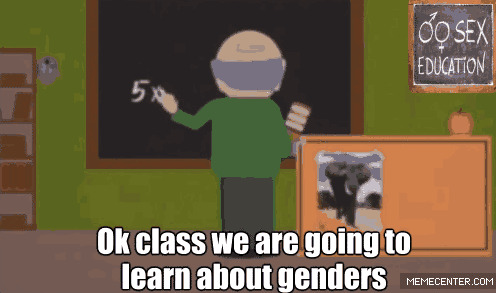
Alas, they are not the same. The two theologies have real differences.
Example from Gnosticism; the fall of Adam is Sophia’s fault, as an esoteric rendition of how Eve is portrayed in Genesis. In addition it was she, in some versions, who birthed the monster Ialdabaoth, the demiurge creator, the false God of the Old Testament.
Need I even mention that the Rosicrucians did not see the OT deity as Satan?
Rosicrucianism; the story is different. Adam fell of his own stupid fault, as a matter of self-willing things into existence, depending if you look at German Theosophy, or the Universal Adam of Pasqually. Eve is not at fault, the splitting of this Universal Adam into two beings is the first fall. The second fall was being cast out of paradise. The woman was not to blame…
There are however some redeeming Gnostic text;
The Apocalypse of Adam portrays Eve to be the teacher of Adam in matters of God.
The Gospel of Phillip portrays Eve as one of two Virgins, who create Adam.
The Apocryphon of John explains Eve was sent by the mercy of God to instruct Adam in his ascent to restore himself and return to God. In one passage she is superior to Adam.
The Origin of the Word shows Eve as a virgin who gives birth to her husband.
But, all in all there are just too many inconsistencies within the Gnostic stories that do not match up with Rosicrucianism. And by RC I mean the legends told by Pasqually, Boehme and the Rosicrucian manifstos. They each tell the same story, without any disagreement.
The problem of Gnosticism is all about the position of the feminine.
Compare how in Valentinian Gnosticism Sophia is separated from her consort and is expelled from heaven. It is Christ (the male) who must descend to her and so that she may rejoin him. Some scholars have seen this as an allegorical interpretation of Genesis, where Eve is transformed into Sophia, and Adam as the heroic Christ.
On a superficial level Gnosticism seems to agree on many points. It was Plato who first described the androgynous Super Human Being, which was later divided into two sexes. This is the origin of our Universal Adam conception in RC thought. BUT, the Valentinians made use of this legend in another way, saying that Sophia was expelled from the heavens because it was she who decided to split from the androgene, thus dividing it into two.
Thus in both the religious Genesis and the Gnostic myth, woman was still to blame.
The Valentinian Exposition 34 says that Sophia ‘cut herself off from her consort’ and this resulted in the creation of the material universe. This earth is all her fault too.
The Gospel of Philip seemed well and good as shown above, but it states that ‘Eve separated from Adam because she was never united with him in the Bridal Chamber.’ Sophia, as the lesser aeon, was intended to unite with Christ in the Bridal Chamber, to complete her initiation.
Thus the separation of Sophia/Eve is described as the origin of our broken relationship with God. If you ask me the story is dark and terrible and sounds like the kind of thing you could use to start your own sex cult… The Gospel of Philip also says “When Eve was still in Adam death did not exist. When she separated from him death came into the world.”
Really the Gnostic Sophia is something of a miserable wreck that needs redeeming.
Christ, as the male figure, must of course come to the rescue.
Sheesh I’m starting to sound like a touting feminist, BUT – the Rosicrucian story is different.
As you can see, Gnosticism is at times contradictory, it presents ideas that don’t match up, the various sects all disagreed with each other and it is just messy. So to make clear;
The Rosicrucian traditions were unanimous
on the divine qualities of Sophia
A reading of the two dramas of the Rosicrucians, being the Theosophy of Boehme and the Pansophy of the Rosicrucians, has a clear message; Venus/Sophia is the Repair-ess.
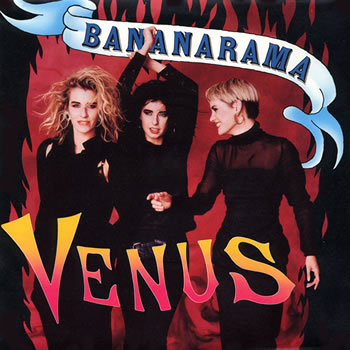 For the Rosicrucian Pansophists Venus was the rebirther of CRC into the divine child.
For the Rosicrucian Pansophists Venus was the rebirther of CRC into the divine child.
This Chemical Wedding story mirrors Jacob Boehme’s masterful teachings which went further.
For the Theosophers of Boehme it was Sophia who allowed us to rebirth Christ within.
Here she, as Virgin, would visit us, enshroud us, and allow us to become pregnant with the spirit of Christ within. In Rosicrucian mysticism we pray for Sophia to visit us.
This brings us to the conclusion to state that; the Sophianic mystery of the Theosophers is that of the Rosicrucians, that in fact there is no difference between the two doctrines, the message and the means.
Both traditions offer us with the most beauteous vision of the divine feminine.
In comparison Gnosticism is an inconsistent/pessimistic mess. Need I remind that while the Rosicrucians loved Nature, the Gnostics saw Nature as false prison?
In total no points are deducted for the penalty Against Gnosticism Score.
Most readers will not realize just how practical the Sophianic path of Boehme really is.
In total the M.O gets a total of 17/20 for it Christosophia Score
Well done to the M.O, this is one of the highest scores yet! 🙂
This wraps up today’s post friends. Stay tuned for more!
Have a lot on my plate but have quite a few exciting upcoming blog post planned, including more insight into the Hermetic gods above the Rosicrucian tomb, the final review of the M.O for its Pansophy score, a few interviews from proud members of AMORC and the M.O, the discovery of secret Rosicrucian gardens of initiation in Germany (which is a BIG one) and the most important yet: the connection between Asclepius, god of healing and C.R.C.
Phew! Keep our community great, share explore and be good to each other!
Your friend, Samuel Robinson
Founder of Pansophers.
Update: See the full Martinist Order Review final say.


